

Chapter 6 How to run a data visualization project. Every data viz project begins with a need, whether that needs come from a problem, decision, or clarification, there is a certain process for each project.
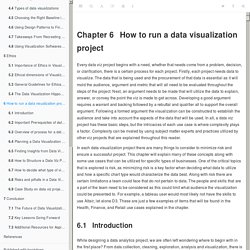
Firstly, each project needs data to visualize. The data that is being used and the procurement of that data is essential as it will mold the audience, argument and metric that will all need to be evaluated throughout the steps of the project. Next, an argument needs to be made that will utilize the data to explain, answer, or convey the point the viz is made to get across.
Developing a good argument requires a warrant and backing followed by a rebuttal and qualifier all to support the overall argument. Following a formed argument the visualization can be constructed to establish the audience and take into account the aspects of the data that will be used. In each data visualization project there are many things to consider to minimize risk and ensure a successful project. Introduction Step 1: Understanding the Business Issues Tips: 1. Statistical Thinking - Free Online Statistics Course. Here’s why so many data scientists are leaving their jobs. Big data is like teenage sex: everyone talks about it, nobody really knows how to do it, everyone thinks everyone else is doing it, so everyone claims they are doing it… — Dan Ariely This quote is so apt. Many junior data scientists I know (this includes myself) wanted to get into data science because it was all about solving complex problems with cool new machine learning algorithms that make huge impact on a business.
This was a chance to feel like the work we were doing was more important than anything we’ve done before. However, this is often not the case. In my opinion, the fact that expectation does not match reality is the ultimate reason why many data scientists leave. Every company is different so I can’t speak for them all but many companies hire data scientists without a suitable infrastructure in place to start getting value out of AI.
7 Steps of Business Analytics Process. Top 65 Data Analyst Interview Questions And Answers For 2020. The word ‘Data’ has been in existence for ages now.
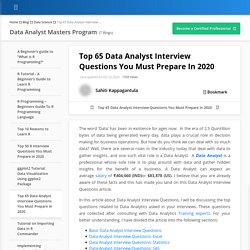
In the era of 2.5 Quintillion bytes of data being generated every day, data plays a crucial role in decision making for business operations. Emerging Data Roles: The Analytics Engineer. Analytics Engineer: this term has started showing up in blog posts and job listings.
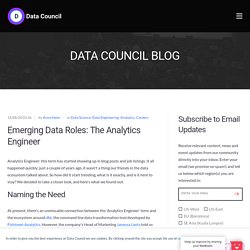
It all happened quickly; just a couple of years ago, it wasn't a thing our friends in the data ecosystem talked about. So how did it start trending, what is it exactly, and is it here to stay? We decided to take a closer look, and here's what we found out. Naming the Need At present, there's an unmissable connection between the 'Analytics Engineer' term and the ecosystem around dbt, the command line data transformation tool developed by Fishtown Analytics. "It started popping up in the dbt community in 2018. Lecture2 big data life cycle. Analytical Skills Definition, List, and Examples. Employers look for employees with the ability to investigate a problem and find the ideal solution in a timely, efficient manner. The skills required to solve problems are known as analytical skills. Hiring managers desire a person who uses clear, logical steps and excellent judgment to understand an issue from all angles before executing an action.
Solutions can be reached by clear-cut, methodical approaches or more creative and lateral angles, depending on the objective. Both ways of solving a problem require analytical skills. What Are Analytical Skills? Analytical skills refer to the ability to collect and analyze information, problem-solve, and make decisions. Analytical skills might sound technical, but we use these skills in everyday work. You use analytical skills when detecting patterns, brainstorming, observing, interpreting data, integrating new information, theorizing, and making decisions based on multiple factors and options available. Types of Analytical Skills Communication. - Creativity Matters - The Creative Leadership Forum - Collaborate - Create - Commercialise & Transformational Change.
Just a think-piece really.
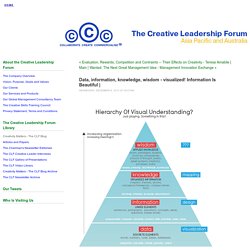
(I was recently visiting the office of the awesome design website Swiss Miss. Over snacks, they asked me to christen their “lunch guest wall” with a scribble. Caught in the headlights and feeling the pressure to be clever and impressive, my mind, of course, went blank. Spotless white. All I had was a noodle in my notepad about the increasing organisational structure of information and how it might relate to visualization. I got kinda stuck with it. This is by no means original thought. One interesting thing. Practical skills that practical data scientists need. The long story short, data scientist needs to be capable of solving business analytics problems.
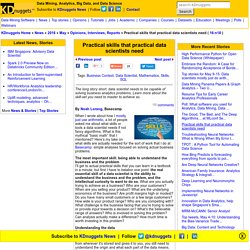
Learn more about the skill-set you need to master to achieve so. By Noah Lorang, Basecamp. When I wrote about how I mostly just use arithmetic, a lot of people asked me about what skills or tools a data scientist needs if not fancy algorithms. What is this mythical “basic math” that I mentioned? Here’s my take on what skills are actually needed for the sort of work that I do at Basecamp: simple analyses focused on solving actual business problems.
The most important skill: being able to understand the business and the problem. AnalyticBridge - Data Intelligence, Business Analytics. Home - Inside Analysis. Business Intelligence - BeyeNETWORK: Global coverage of the business intelligence ecosystem. The Community for Information Management, Business Intelligence & Analytics.